英语语法之关系从句
关系从句 状语从句
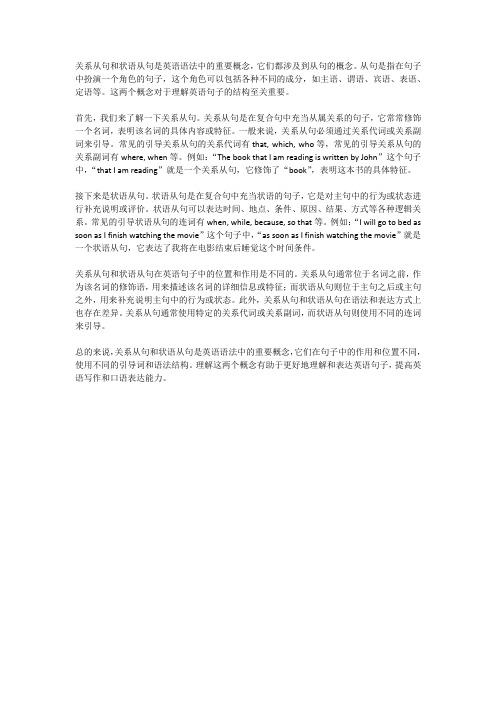
关系从句和状语从句是英语语法中的重要概念,它们都涉及到从句的概念。
从句是指在句子中扮演一个角色的句子,这个角色可以包括各种不同的成分,如主语、谓语、宾语、表语、定语等。
这两个概念对于理解英语句子的结构至关重要。
首先,我们来了解一下关系从句。
关系从句是在复合句中充当从属关系的句子,它常常修饰一个名词,表明该名词的具体内容或特征。
一般来说,关系从句必须通过关系代词或关系副词来引导。
常见的引导关系从句的关系代词有that, which, who等,常见的引导关系从句的关系副词有where, when等。
例如:“The book that I am reading is written by John”这个句子中,“that I am reading”就是一个关系从句,它修饰了“book”,表明这本书的具体特征。
接下来是状语从句。
状语从句是在复合句中充当状语的句子,它是对主句中的行为或状态进行补充说明或评价。
状语从句可以表达时间、地点、条件、原因、结果、方式等各种逻辑关系。
常见的引导状语从句的连词有when, while, because, so that等。
例如:“I will go to bed as soon as I finish watching the movie”这个句子中,“as soon as I finish watching the movie”就是一个状语从句,它表达了我将在电影结束后睡觉这个时间条件。
关系从句和状语从句在英语句子中的位置和作用是不同的。
关系从句通常位于名词之前,作为该名词的修饰语,用来描述该名词的详细信息或特征;而状语从句则位于主句之后或主句之外,用来补充说明主句中的行为或状态。
此外,关系从句和状语从句在语法和表达方式上也存在差异。
关系从句通常使用特定的关系代词或关系副词,而状语从句则使用不同的连词来引导。
总的来说,关系从句和状语从句是英语语法中的重要概念,它们在句子中的作用和位置不同,使用不同的引导词和语法结构。
英语语法高中从句语法

英语语法高中从句语法高中的英语语法是比较基础的,我们来讲一讲它的一些从句类的吧。
下面是店铺给大家整理的高中英语从句语法,供大家参阅!高中英语从句语法:同位语从句1、关联词不能省略2、从句用陈述语序从句的名词后接同位语fact, idea, word,promise, saying,problem, news常见引导词that, whether, where, how, etc.The facts that he succeeded in the experiment pleased us.An idea came to her that she might do that in another way.Scientists have argued over the problem whether there is life on other planets.高中英语从句语法:表语从句1、关联词不能省略2、从句用陈述语序常见引导词what, when, where, why, whether, how, that, because, which, What surprised me most was that he spoke English so well.The question is how what you’ve said can be put into practice.The reason (why ) he didn’t come is that he was ill.It (This , That) is because iron contains more carbon than steel.高中英语从句语法:名词从句概述一.定义: 在句中的作用相当于一个名词的从句叫做名词性从句二.分类: 名词性从句包括四类, 分别是: 主语从句, 宾语从句, 表语从句, 同位语从句三.引导词: 名词从句的引导词包括连词that / if / whether, 连接代词who / whom / whose / what / which, 连接副词when / where / how / why, 另外还有: whatever, whichever, whoever等主语从句一.定义: 在句中充当主语的从句就是主语从句二.示例:a. That he looked at me in that strange way puzzled me.b. Whether we can control the floods is still uncertain.c. What he wanted to see was an end to all the armies of the world.d. When the broadcast station will be ready is unknown.e. Who made the long distance call to him is not important.f. Whether we’ll go depends on the weather.三.应注意的问题:1.以that引导主语从句时, 常用it作形式主语, 而把真正主语后移, 如在以下句型中就是如此: It is + adj / n + that...; It is said / reported / hoped that...a. It is certain that fuels like coal and oil cause a lot of pollution.b. It was said that only three people in the world could understand it at that time.2.whether引导主语从句时, 常置于句首(此时whether不能用if 代替), 也有后移的用法 (此时whether可以用if代替)a. Whether they will come is not yet known.b. It is not yet known whether they will go there.3.连接代词who, what, which和连接副词when, where, how, why引导主语从句时, 一般不后移a. What I told you last night was really true.b. Which team will win the game is not yet known.c. How they went to the USA is still a puzzle.宾语从句一.定义: 在句中充当宾语的从句就是宾语从句. 谓语动词, 非谓语动词, 介词都可以带有宾语从句二.示例:1.谓语动词的宾语从句:a. They knew that the habit may kill them.b. She asked whether / if there were any chemist’s shops in this street.c. The teacher told them who first invented the television set.d. I want to know whose notebook is left on the table in the reading room.e. Can you tell me where the Great Pyramid is ?2.非谓语动词的宾语从句:a. Having known what he had done in school, his father was very angry.3.介词的宾语从句:a. They talked half an hour about what happened in the school.b. He is pleased with what we did yesterday.c. Leifeng always thought of how he can do more for the people.三.应注意的问题:1.句中有宾语从句且有宾补时, 通常用it作形式宾语, 而把宾语从句移到宾补后a. We think it wrong that he didn’t hel p Tom.b. I feel it possible that you will finish the work in a day.2.that从句一般不作介词的宾语, 但except等少数表示“除外”的介词除外a. I know nothing about him except that he lives next door.3.关于主句和宾语从句的时态呼应:①.如果主句是过去时, 宾语从句应是“过去”范畴的某时态a. He said he would fly to Egypt next day.b. He remembered that he had left her umbrella in the library.②.如果宾语从句表示的是客观真理或普遍现象, 可以保持“现在”范畴时态, 而不与主句时态呼应a. The teacher told us that light travels faster than sound.③.如果主句是一般现在时或一般将来时, 宾语从句根据情况选用所需要的时态4.关于宾语从句的“否定转移”: 主句的谓语动词为这些词( think, believe, expect, imagine, suppose, guess等)时, 宾语从句的否定转移到主句中去a. I don’t think he will come.b. I don’t think there are living things on the moon.表语从句一.定义: 在句中充当表语的从句就是表语从句二.示例:a. My idea is that we should help mother do house work every day.b. The question is whether we can catch the early bus.c. Nicotine! That’s what the smokers need.d. Ten years of hard work! That’s why I now look so old.同位语从句一.定义: 在一个名词或代词(如: news, fact, idea, hope, promise, problem, possibility等)后面, 对其作进一步的解释、说明的从句称为同位语从句二.示例:a. I don’t know the fact that the fireman was killed in the fire.b. I have no idea when Jack will be back.c. He can’t answer the question how he got the money.d. There is no doubt that she is fit for the job.e. The news that our team has won the game is very exciting.f. I didn’t tell mother the fact that I met with an accident on my way home.常见问题一.that引导名词从句与定语从句的区别:1.引导名词从句的that本身无词义, 只起引导作用, 在从句中并不充当任何句子成分; 而引导定语从句的that是关系代词, 有词义(指代先行词), 除了起引导作用之外, 还在从句中充当句子成分2.引导宾语从句的that可省略, 引导其他名词从句的that一般不能省略; 而引导定语从句的that如果在定语从句中充当宾语, 也可以省略a. I know that smoking does harm to people’s health. (宾语从句)b. The text tells me a fact that I have already known. (定语从句)c. The news that he had passed the examination made her parents very happy.(同位语从句)d. The news that he told me yesterday made me surprised.(定语从句)二.which引导名词从句与定语从句的区别:which引导名词从句时, 其含义是“哪一个, 哪一些”; which引导定语从句时, 指代先行词, 其含义就是先行词的意思a. There are so many beautiful caps in the shop. I really don’t know which one I should choose.(宾语从句)b. I will never forget the days which we spent in the countryside. (定语从句)三.that / what引导名词从句的区别:引导名词从句时, that本身无词义, 只起引导作用, 在从句中也不充当任何句子成分; what有词义, what引导的名词从句的含义是“…的事 / 物 (任何抽象的或具体的物) ”, what在从句中也充当一个成分a. They knew that the habit may kill them.b. What he wanted to see (“他想看到的事”)was an end to all the armies of the world.c. Nicotine! That’s what the smokers need.(“抽烟者所需要的东西”)四.引导名词从句时只用whether, 不用if的情况:1.引导主语从句时:a. Whether the 2000 Olympic Games will be held in Beijing is not known yet.2.引导表语从句时:a. The problem is whether we need it.3.引导介词后的宾语从句时:a. He was worried about whether he passed the exam.4.与or not连用时:a. It doesn’t matter whether she will come or not.5.置于不定式之前时:a. I don’t know whether to go.6.引导同位语从句时:a. The problem whether we’ll build another school hasn’t been settled.五.名词从句的语序问题: 名词从句中都要使用陈述语序, 参看前文例句2.引导表语从句时:a. The problem is whether we need it.3.引导介词后的宾语从句时:a. He was worried about whether he passed the exam.4.与or not连用时:a. It doesn’t matter whether she will come or not.5.置于不定式之前时:a. I don’t know whether to go.6.引导同位语从句时:a. The problem whether we’ll build another school hasn’t been settled高中英语从句语法:状语从句一.定义: 在句中作状语的从句就叫做状语从句二.分类: 状语从句包括以下八类1.时间状语从句: 由when, while, as, before, after, since, till / until, as soon as等引导a. I shall tell him the good news when he comes.2.原因状语从句: 由because, as, since, for等引导a. He didn’t hear me because he was listening to the radio.b. Since you are free today, you had better show me how to use the computer.3.地点状语从句: 由where等引导a. Please put the book where it was after you finish reading it.4.条件状语从句: 由if, unless等引导a. I will come to see you if I have time on Sunday.5.比较或方式状语从句: 由than, as, as if, as...as...等引导a. I know you do better than he does.b. The old worker runs very fast as if he were a young man.6.目的状语从句: 由so that, in order that等引导a. They set out early so that they could arrive at the station in good time.7.结果状语从句: 由so, so that, so / such...that...等引导a. They set out early so that they arrived at the station in good time.b. He finished his work so well that the boss praised him inpublic.8.让步状语从句: 由though / although, even if, whatever, whoever, whenever, no matter what / who等引导a. He is in very good health though he is old.b. They didn’t stop working even if it began to rain hard.三.应注意的问题:1.时间和条件状语从句中常用一般时代替将来时a. I will go and see a film if I have time tomorrow.b. I will tell the about it as soon as he comes back.c. He said he would go out for a walk when he finished his work.2.状语从句中可有省略: 在一个含有状语从句的复合句中, 如果主句和状语从句的主语相同, 或状语从句的主语是it, 并且状语从句的谓语含有be动词时, 可以将状语从句的主语和be一起省略掉a. As (she was ) a child, she began to learn English.b. If ( he was ) alive, he must be at least ninety years old.c. Although ( he was ) told to stop, he kept on working.d. If ( it is) necessary, ring me up.e. He didn’t sa y a single word until ( he was ) asked.3.as和than引导的比较状语从句中, 从句中和主句中相同的部分往往省略, 从句中只剩下比较对象a. He is a head taller than I ( am tall ).than之后的人称代词是主格或宾格时, 有时意思不同, 如:a. She likes the dog more than me.=She likes the dog more than she likes me.她喜欢狗比喜欢我更多b. She likes the dog more than I.=She likes the dog more than I like the god. 她比我更喜欢狗4.含有no sooner…than…和hardly / barely / scarcely …when…的句子相当于含有as soon as…引导的时间状语的句子. no sooner或hardly放在句首时, 主谓要部分倒装a. He had no sooner seen the policeman than he ran away. =No sooner had he seen the policeman than he ran away. =He ran away as soon as he saw the policemen.b. He had hardly sat down when the telephone rang. =Hardly had he sat down when the telephone rang. =The telephone rang as soon as he sat down.5.immediately, directly, instantly等词也可以作为连词引导时间状语从句, 相当于as soon as引导的时间状语a. I went to see him immediately I heard from him. =I went to see him as soon as I heard from him.6.the moment, the minute, the second引导时间状语从句, 相当于as soon as引导的时间状语a. He let out a cry the moment he saw the snake.=He let outa cry as soon as he saw the snake.7.each time, every time, any time, last time, next time, first time可以引导时间状语从句a. They shake hands with each other each time they meet.8.since引导的时间状语从句中, 若谓语动词是延续性动词或状态动词, 则其过去时表示动作的完成或状态的结束a. It is five years since he lived here. 他不住这里己有五年了a. They shake hands with each other each time they meet.8.since引导的时间状语从句中, 若谓语动词是延续性动词或状态动词, 则其过去时表示动作的完成或状态的结束a. It is five years since he lived here. 他不住这里己有五年了。
定语从句语法讲解英语
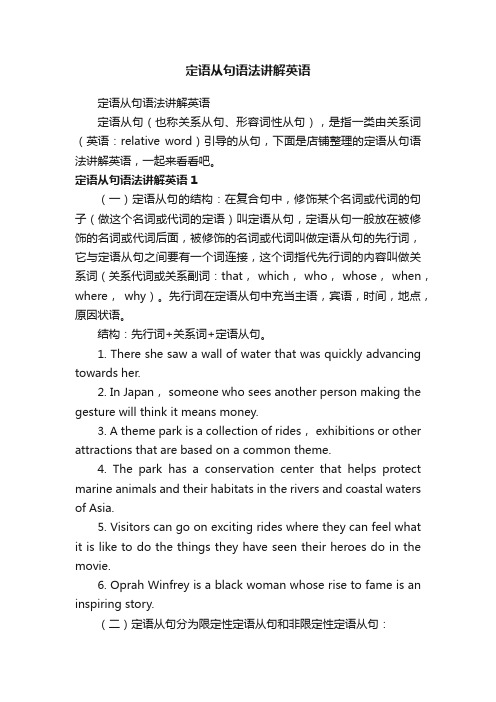
定语从句语法讲解英语定语从句语法讲解英语定语从句(也称关系从句、形容词性从句),是指一类由关系词(英语:relative word)引导的从句,下面是店铺整理的定语从句语法讲解英语,一起来看看吧。
定语从句语法讲解英语1(一)定语从句的结构:在复合句中,修饰某个名词或代词的句子(做这个名词或代词的定语)叫定语从句,定语从句一般放在被修饰的名词或代词后面,被修饰的名词或代词叫做定语从句的先行词,它与定语从句之间要有一个词连接,这个词指代先行词的内容叫做关系词(关系代词或关系副词:that, which, who, whose, when,where,why)。
先行词在定语从句中充当主语,宾语,时间,地点,原因状语。
结构:先行词+关系词+定语从句。
1. There she saw a wall of water that was quickly advancing towards her.2. In Japan, someone who sees another person making the gesture will think it means money.3. A theme park is a collection of rides, exhibitions or other attractions that are based on a common theme.4. The park has a conservation center that helps protect marine animals and their habitats in the rivers and coastal waters of Asia.5. Visitors can go on exciting rides where they can feel what it is like to do the things they have seen their heroes do in the movie.6. Oprah Winfrey is a black woman whose rise to fame is an inspiring story.(二)定语从句分为限定性定语从句和非限定性定语从句:限定性定语从句:从句对先行词进行必要的描述或说明,缺少它,则句义显得不完整,从句与先行词紧密相连。
高中英语 语法 定语从句(关系副词及介词加关系代词引导)课件(共23张PPT)

一、句型转换 1. I shall never forget the day when New China was founded.
I shall never forget the day _o_n__w_h_i_c_h_ New China was founded.
2. Is this the place where that traffic accident occurred?
has
not only built up my body but also shaped
my character. In addition, I have made
some friends
have the same interest
as me. All in all, I think students should
3. There are two buildings, the larger of _w__h_i_ch__ stands nearly a hundred feet high.
4. The English play in _w__h_ic_h__ my students acted at the New Year’s party was a great success.
⑵ The factory __th_a_t__ we visited yesterday is in the west of the city.
⑶ The factory _in__w_h__ic_h_ there are many modern machines is in the
west of the city.
⑶ The colorless gas is called oxygen, _in__w_h_i_c_h_ fires burn much better.
英语语法从句

Lecture Twelve 理科班英语语法篇(十二)从句一.从句的分类从句不能单独成句,但它也有主语部分和谓语部分,就像一个句子一样。
所不同在于,从句须由一个关联词引导。
根据引导从句为主不同大概可分为:主语从句、表语从句、宾语从句、同位语从句、定语从句和状语从句6类。
前四类由于主语从句、表语从句、宾语从句及同位语从句在句子的功用相当于名词,所以通称名词性从句;定语从句功能相当于形容词,称为形容词性从句;而状语从句功能相当于副词,称为副词性从句。
状语从句还可以分为条件状语从句、原因状语从句、地点状语从句、目的状语从句、让步状语从句、比较状语从句、方式状语从句、结果状语从句和时间状语从句。
二.各从句在句子中的位置以及用法:(1)主语从句:在句子中充当句子主语的从句叫主语从句。
位于谓语动词之前。
通常由that,whether以及疑问连词引导。
一般情况下,常用it替代主语从句,而将主语从句移到句尾。
如:When we should start is still a question. (我们该在什么时候开始还是个问题呢。
)(2)表语从句:在句子中作连系动词的表语的从句,它位于主句中的系动词之后。
例如:That is why he did not come to school yesterday. / It is because you are so clever.(3)宾语从句:在句子中作及物动词或介词的宾语。
①基本形式:(主句+)连词+从句主语+从句谓语+...②关于宾语从句连词的选择:若从句来源于一个陈述句,那么,连词用that,在口语中that可以省略;例如:They believe that the computer will finally take the place of human beings.(他们相信计算机终将代替人类。
) (从句本来就是陈述句)若从句来源于一个一般疑问句,连词则用if 或whether;例如:I wonder whether I should say something for him to the headmaster. (我不知道是不是该为他在校长跟前说点什么。
英语语法学习-定语从句---关系代词引导的定语从句
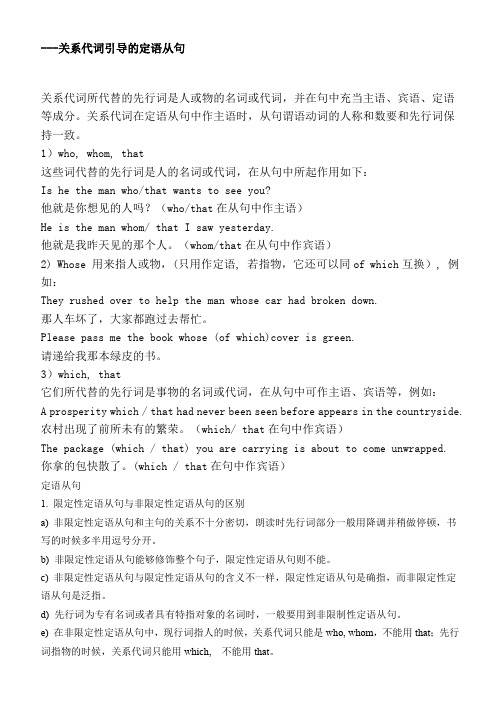
---关系代词引导的定语从句关系代词所代替的先行词是人或物的名词或代词,并在句中充当主语、宾语、定语等成分。
关系代词在定语从句中作主语时,从句谓语动词的人称和数要和先行词保持一致。
1)who, whom, that这些词代替的先行词是人的名词或代词,在从句中所起作用如下:Is he the man who/that wants to see you?他就是你想见的人吗?(who/that在从句中作主语)He is the man whom/ that I saw yesterday.他就是我昨天见的那个人。
(whom/that在从句中作宾语)2) Whose 用来指人或物,(只用作定语, 若指物,它还可以同of which互换), 例如:They rushed over to help the man whose car had broken down.那人车坏了,大家都跑过去帮忙。
Please pass me the book whose (of which)cover is green.请递给我那本绿皮的书。
3)which, that它们所代替的先行词是事物的名词或代词,在从句中可作主语、宾语等,例如:A prosperity which / that had never been seen before appears in the countryside. 农村出现了前所未有的繁荣。
(which/ that在句中作宾语)The package (which / that) you are carrying is about to come unwrapped. 你拿的包快散了。
(which / that在句中作宾语)定语从句1. 限定性定语从句与非限定性定语从句的区别a) 非限定性定语从句和主句的关系不十分密切,朗读时先行词部分一般用降调并稍做停顿,书写的时候多半用逗号分开。
b) 非限定性定语从句能够修饰整个句子,限定性定语从句则不能。
高一英语语法定语从句之关系代词课件共49张

A
3. It is the most interesting book ___I’ll ever
read. A. which B. that
B
第28页,共50页。
4.The person __A_finds my watch will get a reward. A. who B. when
6. The girl ____ leg was broken in the earthquake was taken to hospital. (who / whom / whose)
7. The student ____ the teacher praise at the class meeting is our monitor. (which / whhoomm / whose)
which you bought yesterday.
单词作定语时通常放在它所修饰的词之前,作前置定语。
短语和从句作定语时则放在所修饰的词之后,作后置定语。
第4页,共50页。
3.先行词: 被修饰的名词或代词叫先行词; 4.关系词:引导定语从句的关联词称为关系词,关
系词有关系代词和关系副词。 关系代词that, which, who, whom, whose, as 关系副词where, when, why等。 关系词常有3个作用:
The woman who lives next door is a teacher.
1、找准主句,并确定先行词。 2、找准关系词,来代替先行词
第19页,共50页。
Practise: 1. The boys are from Grade one. The boys are playing basketball. The boys who/that are playing basketball are from Grade One.
英语三大从句语法讲解

英语三大从句在英语中,主要有三大从句,即名词性从句包括主语从句,宾语从句,表语从句,同位语从句、形容词性从句即定语从句、副词性从句即状语从句,包括时间、条件、结果、目的、原因、让步、地点、方式等;定语从句一、关系代词引导的定语从句关系代词代替前面的先行词,并且在定语从句中充当句子成分,可以作主语、宾语、定语等;常见的关系代词有:who, that, which;它们的主格、宾格和所有格如下表所示:一关系代词who, whom和 whose的用法who代替人,是主格,在定语从句中作主语;An architect is a person who designs buildings. 建筑师是设计房屋的人;whom代替人,是宾格,在定语从句作宾语,在非正式英语常可省略;Do you know the gentleman whom we met in the school library yesterday 昨天我们在学校图书馆里遇到的那位先生你认识吗whose一般代替人,有时亦可代替物,是所有格,在定语从句作定语;The girl student whose father is a senior engineer used to study abroad. 其父是一位高级工程师的那个女学生过去在国外留学;Do you know the name of the hotel whose window we can see here 我们这儿能看到窗户的那个宾馆叫什么名字,你知道吗关系代词whose指代先行词hotel,正式用法应该用of which;whose window=the window of which,意思是:the window of the hotel;二关系代词which的用法which代替物,在定语从句作主语或宾语,作宾语时还可省略;I do not like stories which have unhappy endings.我不喜欢有不幸结局的小说;which可以换成that三关系代词that的用法that既可指人又可指物,在当代英语中大多指物,在定语从句作主语或宾语,作宾语时还可省略;: Is she the girl that sells newspapers她是卖报纸的那个女孩吗that可以换成whoWhere is the ice-cream that was in the fridge放在冰箱的冰激凌哪儿去了that可以换成whichIs this the book that you want to buy这是你要买的那本书吗 that可以换成which,在定语从句作宾语,还可以省略二、关系副词引导的定语从句常用的关系副词只有三个:when, where, why,在定语从句中充当时间、地点和原因状语;一关系副词when的用法关系副词when代替的先行词表示的是时间,when在定语从句作时间状语;In Beijing July and August are the months when it rains very often.北京的七月和八月是常下雨的月份;when先行词是months二关系副词where的用法关系副词where代替的先行词表示的是地点,where在定语从句作地点状语;During the Spring Festival I went back to the town where I was brought up.春节期间,我回到了生我养我的家乡;where的先行词是town三关系副词why的用法关系副词why代替的先行词表示的是原因,why在定语从句作原因状语;The reason why I am phoning you is to ask you whether you have got my email.我打电话给你的原因是想问问你是否收到了我的电子邮件;why先行词是reason, 当代英语里why可以用that替代,这时关系代词that就变成了表示原因的关系副词,还可以将why省略三、特殊关系代词as引导的定语从句一在固定搭配as…as, so…as, such…as, the same…as中,as引导定语从句You may take as many books as you want.你想要拿多少书就拿多少;第一个as是副词,修饰many的;第二个as才是关系代词,代替先行词books,在定语从句中作宾语二独立于主句之外,as引导定语从句As we know/ As is known to us, the earth turns around the sun. 正如我们所知,地球围绕太阳旋转;As we know和 As is known to us均为定语从句,as分别作宾语和主语,替代后面的主句;Taiwan is, as you know, an inseparable part of China.你知道,台湾是中国不可分割的一部分;关系代词as指代整个主句,在定语从句中作宾语;四、关系代词who, which与that的区别一关系代词who与that的区别1. 当关系代词用作主语时,多用主格who;He who loses hope loses all.失去希望的人就失去一切;先行词为代词he, they, any, all, one等时,多用whoI met Alice, who told me that she was learning Chinese.我遇见艾丽斯,她告诉我她在学汉语;在非限制性定语从句中,用who2. 当关系代词用作介词后的宾语时,用宾格whom,不用that;The man to whom our headmaster talked just now is our English teacher.我们校长刚才与他谈话的那个人是我们的英语老师;介词与关系代词紧密相连时,只能用宾格whom,不可用主格who注意:介词与关系代词不是紧密相连时,或者说介词放在句子后面时,这时可以用主格who,也可用that,还可以省略关系代词;因此,上面的这句话还可以有如下四种说法:1 The man whom our headmaster talked to just now is our English teacher.2 The man who our headmaster talked to just now is our English teacher.3 The man that our headmaster talked to just now is our English teacher.4 The man our headmaster talked to just now is our English teacher.3. 当关系代词泛指人时,多用that;He is a man that is never afraid of failure.他是个从不怕失败的人;that用来泛指人4. 当关系代词出现在who开头的疑问句时,应用that;例如:Who is the girl that is talking to Tom in English用英语同汤姆交谈的那个女孩是谁避免重复使用who,以免造成误解或语义含混不清二关系代词which与that的区别1. 当先行词为all, much, little以及不定代词anything, something, everything等时,关系代词多用that;All that glitters is not gold. 闪闪发光物,未必尽黄金;She told me everything that she knew. 她把她所知道的一切都告诉了我;2. 当先行词的前面有形容词最高级、序数词或限定词the only, the very, all, every, any, no 等时,关系代词一般都用that;This is the best novel that I have ever read. 这是我读过的最好的一部小说;He is the only person that has been invited to the ball. 他是惟一应邀参加舞会的人;3. 当关系代词出现在which开头的疑问句时,应用that;Which was the hotel that was recommended to the foreign guest 哪一个是推荐给外宾的宾馆这里使用that很明显是为了避免重复which4. 在非限制性定语从句中,关系代词一般只用which;Beijing, which is the capital of the People’s Republic of China, will host the 2008 Olympic Games. 北京是中华人民共和国的首都,将主办2008年奥运会;5. 介词后的关系代词用which,而不用that;She has collected 600 stamps, 60% of which are German stamps. 她收集了600张邮票,其中60%是德国邮票;五、定语从句的位置如前所述,定语从句一般总是直接置于所修饰的名词或代词之后;有时候,定语从句与先行词之间插入了其他的短语,这样它们被分隔了,这种情况下的定语从句被称作隔离定语从句;There was a girl upstairs who was shouting and crying, obviously mad.楼上有一个女孩,大喊大叫;很明显,她疯了;定语从句who was shouting and crying修饰the girl,被upstairs所隔开A new master will come tomorrow who will teach you German.明天要来一位新老师教你们德语了;定语从句置于句末以示强调名词性从句宾语从句一、引导词1由that 引导的陈述句性的宾语从句,在很多动词如say, think, wish , hope, see, believe, agree, expect, hear , feel等动词后;连词that只起连接作用,在从句中不做句子的成分,也无词汇意义,在口语中常被省略;如:I told him that he was wrong.在think, believe, suppose, expect等动词引起的宾语从句中,有时谓语尽管是否定意义,却不用否定形式,而将think 等动词变为否定形式;见语法:否定转移如:I don’t think you are right. 我认为你做的不对在许多带有复合宾语的句子中,that引导的宾语从句经常移到句子的后面,而用it做形式宾语;We think it wrong that he told a lie to everyone 我认为他向每一个人撒谎是错误的2 由连词if、 whether 引导的表示“是否…”的宾语从句;Whether, if 在从句中不做句子的成分,一般情况下,whether和if 可以替换;I don’t know if/whether he will come tomorrow.在介词后面的宾语从句中不用if引导Everything depends on whether we have enough money.宾语从句中有or not时不用if引导.I don’t know whether the movie star will come or not.和不定式连用作宾语时不用if引导Whether to go there or not hasn’t been decided.3由wh-引导的宾语从句;连接代词who, whom, whose, what, which和连接副词when, where, why, how 等连接的宾语从句,它们在句中即有连接从句的作用,又在句中充当句子的成分;Do you know which film they are talking about which做定语I don’t know where he lives. where 做地点状语二、宾语从句的语序,宾语从句的语序必须是陈述语序,既连接词+主语+谓语+其他成分 I believe that they will come soon.特例:有下列常见的问句,作为从句出现,是“不改变语句顺序”的;1. What's the matter2. What's wrong3. What's up4. What's the problem5. What's your trouble三、宾语从句的时态;宾语从句的时态受主句的限制,即:主句是一般现在时态,从句根据实际情况而定;主句是一般过去时态,从句用相应的过去的时态;如果从句的动作发生在主句之前,则从句要用过去完成时态;1 She says that she is a student.→ She said that she was a student.2She says that she will fly to Japan in a week. → She said that she would fly to Japan in a week.3She says that she has finished her homework alre ady. → She said that she had finished her homework already.1如果宾语从句说的是客观真理、自然现象或事实时,这时宾语从句要用一般现在时态;The teacher said that the earth goes round the sun.2Could you tell me…是用来征询对方的意见,语气委婉,并不表示过去;Could you tell me when we will visit the History Museum注意事项:3由陈述句变成宾语从句时,要注意人称的变化;She said: “I have been to England before.” → She said that she had been to England before. She asked me: “Do you like maths” → She asked me if I liked maths.4宾语从句与简单句的交换;由连接代词和连接副词引导的宾语从句,如果宾语从句的主语和主句的主语是同一个人时,可以用“疑问词+不定式”做宾语的简单句结构;I don’t know what I should do next. → I don’t know what to do next.DO SOME EXERCISES:you see AA. what he’s readingB. what is he readingC. what does he readD. he reads what2. Does Jack come from Japan Do you know合并成一个句子Do you know ___that__Jack __come___from Japandid your son say in the letter_He told me that he_D__ the Disney the next day.A. will visitB. has visitedC. is going to visitD. would visit4. He didn’t know___A____A. what’s the matterB. what the matter isC. what was the matterD. what the matter was5. Somebody called you just now, but I didn’t know__D__A. who were theyB. who they wereC. who was itD. who it was6. I want to know___D__A. what is his nameB. what’s his nameC. that his name isD. what his name is7. ---Could you tell me __C__she is looking for---Her cousin, Susan.A. thatB. whose C .who D. which8. ---What are you searching the Internet for---I’m trying to find out____.A. What is the difference between SARS and BIRDFLUB. How many persons have died in IraqC. How to protect our environmentD. Why is our Chinese team be able to beat Korea同位语从句一一般来说,在主从复合句中,用作同位语的从句叫同位语从句;它通常跟在某些名词之后,用以说明或解释该名词表示的具体内容;可以跟同位语从句的名词通常有:advice, decision, fact, hope, idea, information, message, news, promise, proposal, reply, report, suggestion, word消息,problem, question, doubt, thought等;eg: They were delighted at the news that their team had won.当听到他们队获胜的消息时,他们欣喜若狂;有时同位语从句可以不紧跟在被说明的名词后面,而被别的词隔开; 如:The thought came to him that Tom might have returned the book.他突然想起汤姆可能已经还了书了;二引导词1. The news that Mr. Li will be our new English teacher is true.2. He hasn’t made the decision whether he will go there.3. The question who should do the work is being discussed at the meeting.4. I have no idea what the boy is doing in the next room now.5. We haven’t yet settled the question where we are going to spend our summer vacation this year.6. I have no idea how I can get to the railway station.7. I have no idea when he will be back.小结:① that引导同位语从句时无词义,也不充当任何成分,但通常不可以省略,如句1;② whether引导同位语从句时意为“是否”,通常不能用if来代替, 如句2;③ 连接代词who, what等可以引导同位语从句,如句3, 4;④ 连接副词where, how, when等可以引导同位语从句, 如句5,6,7;三 that 引导的同位语从句和定语从句① 意义不同:同位语从句用来进一步说明前面名词的内容;而定语从句用来修饰、限定前面的先行词;试比较:1. The news that our team has won the final match is encouraging.2. The news that you told us is really encouraging.② that的功能不同:that引导同位语从句时是一个纯连词,不充当任何成分;而引导定语从句时,不仅起连接作用,而且还指代先行词并在从句中充当主语、宾语等成分;试比较:1. Dad made a promise that he would buy me a CD player if I passed the English test.2. Dad made a promise that excited all his children.③ 可否省略:that在引导同位语从句时,通常不可省略;在引导定语从句时,若在从句中作宾语,通常可以省略,若作主语则不可以省略;DO SOME EXERCISES:I. 请用适当的词填空,使下列句子意思完整;1. They expressed the hope _that_ they would come over to China soon.2. The fact ___that____ he didn’t see Tom this morning is true.3. Word has come __where_____ some American guests will come to our college for a visitnext week.4. He can’t answer the question ___how____ he got the money from his home yesterday.5. Do you have any idea __what___ is actually going on in the classroom6. The problem _______ we should have the meeting in the hall now must be decided at once. II. 下列各句中均有一处错误,请改正;1. Our team has won the game, that made us very happy.2. I’ve come with a message from Mr Wang how he won’t be able to see you this afternoon.3. He must answer the question if he agrees with what she said or not.4. I’ve read the book where you gave me the day before yester day.5. One of the men heldthe opinion when what the book said was right.表语从句表语从句只能置于主句之后,而主句的动词只能是连系动词;名词性从句在be等系动词后作表语时被称为表语从句The problem is how we can get the things we need.问题是我们怎样能弄到我们需要的东西;how 在表语从句中充当方式状语The scissors are not what I need. 这把剪刀不是我所需要的;what 在表语从句中充当宾语What I told him was that I would find him a good play. 我告诉他的是我会给他找个好剧本;what 在主语从句中作直接宾语, that作为表语从句的引导词在该表语从句中不充当句子成分, 不能省略That is what I want to tell you.那就是我想要对你讲的;what在表语从句中充当直接宾语That is why she failed to pass the exam. 那就是她考试不及格的原因;why 在表语从句中充当原因状语“That is why...”是常用句型, 意为“这就是……的原因/因此……”, 其中why引导的名词性从句在句中作表语, 该句型通常用于针对前面已经说明过的原因进行总结下面是两个与“That is why...”形式相似的结构, 它们与“That is why...”结构之间的关系要能够辨析清楚:1“That is why...”与“That is the reason why...”同义, 只不过从语法结构上讲, “That is the reason why...”中why引导的是—个定语从句, 将其中的the reason去掉则与“That is why...”结构一样 That is the reason why I cannot agree.2“That is because...”句型中从属连词because引导的名词性从句在此作表语, 这也是个常用句型, 意为“这就是为什么……/因为……”;“That is because...”与“That is why...”之间的不同在于“That is because...”指原因或理由, “That is why...”则指由于各种原因所造成的后果He did not see the film last night. That is because he had to help his little sister with her homework.昨天晚上他没有去看电影, 那是因为他得帮助他的妹妹做作业;第一句话说明结果, 第二句话说明原因He had seen the film before. That is why he did not see it last night.他以前曾看过那部电影, 因此他昨天晚上没有去看;第一句话说明原因, 第二句话说明结果考题1The traditional view is ____ we sleep because our brain is “programmed” to make us do so. 2007上海A. whenB. whyC. whetherD. that考题2You are saying that everyone should be equal, and this is ____ I disagree. 2004A. whyB. whereC. whatD. how考题3— I drove to Zhuhai for the air show last week.— Is that ____ you had a few days off 1999A. whyB. whenC. whatD. where考题4____ made the school proud was ____ more than 90% of the students had been admitted to key universities. 2003上海春A. What; becauseB. What; thatC. That; whatD. That; because考题5—Are you still thinking about yesterday’s game—Oh, that’s ____. 2003北京春A. what makes me feel excitedB. whatever I feel excited aboutC. how I feel about itD. when I feel excited表语从句与宾语从句的关系宾语从句和表语从句都属于名词性从句;其作用跟名词在句中的作用相同;故充当宾语的句子叫宾语从句,充当表语的句子叫表语从句;宾语从句1对于宾语从句要掌握以下三点①语序: 从句的语序必须是陈述句语序, 即“主语 + 谓语”这种形式;②时态: 当主句是一般现在时或一般将来时的时候, 从句可以是任何时态, 而当主句是一般过去时的时候, 从句时态必须是过去时范围的时态, 即一般过去时, 过去进行时, 过去完成时, 过去将来时;③连接词: 当从句意思完整, 主句意思肯定时, 连接词用that, 且可以省去当从句意思完整, 主句意思不确定或含否定含意时, 常用if或whether是否当从句意思不完整时, 连接词则是代替不完整部分的特殊疑问词;表语从句在句子中起表语作用的从句叫做表语从句,位于主句系动词的后面;表语从句的引导词和主语从句的引导词相同;也是名词性从句的一种;What the police want to know is when you entered the room.警察想知道的是你什么时候进的房间;The trouble is that we are short of funds困难是我们缺乏资金;This is what we should do这是我们应当做的;That is why I want you to work there那就是我要你在那儿工作的原因;His first question was whether Mr. Smith had arrived yet他的第一个问题是史密斯先生到了没有; 从句中的疑问句用正常语序,即陈述语序;as if, as though, because也可用来引导表语从句;She seems as if she had done a great thing她看起来好像做了一件大事;It is because you eat too much那是因为你吃得太多了;状语从句一状语从句的种类1.时间状语从句2.地点状语从句;3.原因状语从句;4.条件状语从句;5.目的状语从句;6.让步状语从句;7比较状语从句;8.程度状语从句;9.方式状语从句;10.结果状语从句;二状语从句的时态一般情况下,时间和条件状语从句的谓语动词一般用“一般现在时”表示“一般将来时”,用“现在完成时”表示“将来完成时”;1时间状语从句1.由when, while, as引导的时间状语从句;when, while和as的区别:when引导的从句的谓语动词可以是延续性的动词,又可以是瞬时动词;并且when有时表示“就在那时”;While引导的从句的谓语动作必须是延续性的,并强调主句和从句的动作同时发生或者相对应;并且while有时还可以表示对比;While my wife was reading the newspaper, I was watching TV.As表示“一边……一边”,as引导的动作是延续性的动作,一般用于主句和从句动作同时发生;as也可以强调“一先一后;As we was going out, it began to snow.当我们出门时,开始下雪了;as强调句中两个动作紧接着先后发生,而不强调开始下雪的特定时间2.由before和after引导的时间状语从句;before引导的从句不再用否定式的谓语,并且当before引导的从句位于主句之后,有时译成“就,才”; 时态:当主句用将来时,从句总是用现在时;如果before引导的从句谓语用的是过去时,则主句动词多用过去完成时,这样以便体现动作发生的先后;After表示主句动作发生在从句动作之后;主句和从句的动作的时间关系正好与before引导的从句相反;3.由till或until引导的时间状语从句;till和until一般情况下两者可以互换,但是在强调句型中多用until;并且要注意的是:如果主句中的谓语动词是瞬时动词时,必须用否定形式;如果主句中的谓语动词是延续性动词时,用肯定或否定形式都可以,但表达的意思不同;4.由since引导的时间状语从句;since引导的从句的谓语动词可以是延续性的动词,又可以是瞬时动词;一般情况下,从句谓语动词用一般过去时,而主句的谓语动词用现在完成时;但在It is +时间+since从句的句型中,主句多用一般现在时;5.由as soon as, immediately, directly, instantly, the moment, the instant, the minute, 等引导的时间状语从句;这些连词都表示“一……就”;hardlyscarcely, rarely…when / before, no sooner…than相当于as soon as之意;主句用过去完成时,从句用一般过去时;当hardly, scarcely, rarely和no sooner位于句首时,主句应用倒装语序;6.由by the time引导的时间状语从句;时态的变化:在一般情况下,如果从句的谓语动词用一般过去时,主句的谓语动词用过去完成时;如果从句的谓语动词用一般现在时,主句的谓语动词用将来完成时;7.由each time, every time和whenever引导的时间状语从句;8.由as long as和so long as引导的时间状语从句;这两个连词表示“只要;和…一样长”;2地点状语从句地点状语从句一般由连接副词where, wherever等引导,已经形成了固定的句型,:句型1:Where+地点从句,there+主句;此句型通常译成“哪里……哪里就……”;主句在从句后面时,there可用可不用;如果主句在从句的前面时,一般都不用there;句型2:Anywhere/ wherever+地点从句,+主句;状语从句是句子的状语由一个从句充当,来修饰主句中的动词,形容词或副词等;状语从句都由从属连词引导,与主句连接,放在句末时,一般不在前面加逗号;3原因状语从句: because, since, as和for都表示原因;because语势最强,回答why提出的问题,用来说明人所不知的原因;当能够很明显的看出原因或人们已知原因,就用as或since;由because引导的从句如果放在句末,且前面有逗号,则可以用for来代替;但如果不是说明直接原因,而是多种情况加以推断,就只能用for;4目的状语从句:表示目的状语的从句可以由in order that, so that,等词引导;5结果状语从句:结果状语从句常由so...that 或 such...that引导,首先要了解so和such后面分别跟什么词;such是形容词,修饰名词或名词词组,so是副词,只能修饰形容词或副词;so 还可与表示数量的形容词many, few, much, little连用,形成固定搭配;The box is so heavy that I can't carry it.6让步状语从句:是由though, although 引导的状语从句;。
2020届高考高中英语“从句篇”语法专题汇总

高中英语“从句篇”语法专题汇总定语从句一、关系代词引导的定语从句1、that 指人或物在从句中作主语,宾语或表语which 指物在从句中作主语,宾语或表语(作宾语时可以省略)who 指人在从句中作主语,宾语或表语whom 指人在从句中作宾语whose 指人或物在从句中作定语as 指人或物在从句中作主语,宾语或表语but 指人或物在从句中作主语,宾语或表语注意:指物时,whose+名词=the+名词+of which或 of which+the+名词2、as 的用法(1)常用于下列结构:such…as; so…as;the same…as; as…as注意:the same…as 表示同一类,不同一个the same…that 表示同一个(2)as与which的区别a、位置不同as可放在主句后,主句前或主句中间;which只能放在主句后。
b、as起连接作用,表达说话人的观点、看法,并指出主句内容的根据或出处,意为“正如,正像”。
Which相当于并列句,可以用and this来代替,意为“这一点,这件事’”。
注意:as常用于下列结构:as we know/ as is known to all, as we all can see, as has been said before/above,as might be excepted, as is often the case, 一般不能用which代替as。
c、在从句中作主语时,which既可作系动词be的主语也可作实义动词的主语,而as只可作系动词be的主语。
3、but用作关系代词,相当于who/that…not例:In China there is no one but knows Lei Feng.二、只用that不用which的情况1、.先行词为 all , much, everything, nothing , something ,anything, nothing, none, the one等不定代词时2、先行词被only, any, few, little, no , all, just , very ,right等修饰时.3、当先行词是最高级或被形容词最高级修饰时。
英语语法之关系副词引导的定语从句

№.4英语语法之关系副词引导的定语从句关系副词是引导定语从句的一类词语,用于连接主句和从句,并在从句中充当状语。
常见的关系副词有:where、when、why。
1. Where(在哪里),用于引导地点状语从句,在从句中充当地点状语,以下是关于where的几点用法:(1)指代具体地点:- This is the school where I study.(这就是我学习的学校。
)- I often go to the caféwhere they serve delicious coffee.(我经常去那家咖啡馆,他们的咖啡很好喝。
)(2)指代抽象地点:- The library is where I find peace and quiet.(图书馆是我找到宁静的地方。
)- The park is where families gather on weekends.(公园是周末家庭聚集的地方。
)(3)表示定位或移动的地点:- He lives in a small town where everyone knows each other.(他住在一个小镇,每个人都互相认识。
)- We went hiking in the mountains where the air is fresh.(我们去了山区徒步旅行,那里空气清新。
)(4)引导限制性定语从句:- I found the book where I left it.(我找到了我放的书。
)- The house where he grew up has been demolished.(他长大的房子已经被拆除了。
)当使用where引导地点状语从句时,需要注意以下几点:(1)确定先行词:在使用where引导定语从句之前,要确保已经明确了先行词,即被修饰的名词或代词。
这样可以使从句更加清晰和连贯。
(2)引导限制性定语从句:where通常用来引导限制性定语从句,对先行词进行具体描述和限定,提供必要的信息。
英语语法之关系代词引导的定语从句
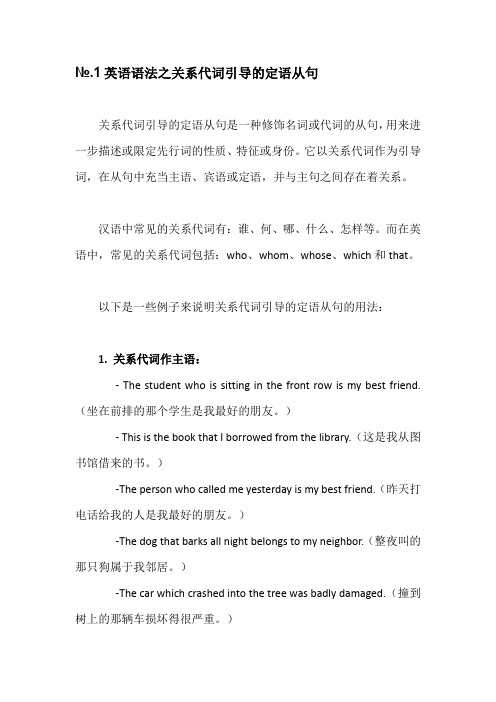
№.1英语语法之关系代词引导的定语从句关系代词引导的定语从句是一种修饰名词或代词的从句,用来进一步描述或限定先行词的性质、特征或身份。
它以关系代词作为引导词,在从句中充当主语、宾语或定语,并与主句之间存在着关系。
汉语中常见的关系代词有:谁、何、哪、什么、怎样等。
而在英语中,常见的关系代词包括:who、whom、whose、which和that。
以下是一些例子来说明关系代词引导的定语从句的用法:1. 关系代词作主语:- The student who is sitting in the front row is my best friend.(坐在前排的那个学生是我最好的朋友。
)- This is the book that I borrowed from the library.(这是我从图书馆借来的书。
)-The person who called me yesterday is my best friend.(昨天打电话给我的人是我最好的朋友。
)-The dog that barks all night belongs to my neighbor.(整夜叫的那只狗属于我邻居。
)-The car which crashed into the tree was badly damaged.(撞到树上的那辆车损坏得很严重。
)-The movie that we watched last night was very entertaining.(我们昨晚看的电影非常有趣。
)-The book which you recommended is on the bestseller list.(你推荐的那本书在畅销书榜单上。
)-The team that won the championship will have a victory parade.(获得冠军的那支队伍将进行胜利游行。
)2. 关系代词作宾语:- The house which he bought last year is very big.(他去年买的那幢房子非常大。
英语语法定语从句知识点:关系代词和关系副词基本用法介绍

【导语】英语语法让很多学⽣都头疼,因为复杂难懂的句式和词组有时难以记忆。
为⼤家整理了英语语法⼤全,希望对同学们的英语语法学习有所帮助。
更多内容尽在。
根据关系词在定语从句中的不同⽤法,可分为关系代词和关系副词。
关系代词主要有who, whom, which, that, whose等,在定语从句中作主语、宾语、定语等;关系副词主要有when, where, why等,在定语从句中作状语。
具体⽤法如下: ⼀、关系代词的⽤法 当先⾏词指⼈时,若它在从句中作主语,则⽤who;若它在从句作宾语,则⽤whom或who;若它在从句中作定语,则⽤whose。
如: The man who told me this refused to tell me his name. 告诉我这事的⼈不肯告诉我他的名字。
The woman whose umbrella you took is very angry about it. 你拿了那个⼥⼈的伞,她⾮常⽣⽓。
当先⾏词指物时,若在定语从句中作主语或宾语,则⽤which;若它在定语从句中作定语⽤,则⽤of which或whose。
如: I saw something in the paper which might interest you. 我在报上看到⼀样可能使你感兴趣的东西。
He’s written a book the name of which (whose name) I’ve forgotten. 他写了⼀本书,书名我给忘了。
⼆、关系副词的⽤法 关系副词主要有when, where, why等,在定语从句中作状语,分别表⽰时间、在点和原因。
when主要放在time, day, years, season, age, occasion等时间的名词后;where主要放在place, city, town, village, house等地点名词后;why则通常只放在reason后。
英语关系从句 英语语法学习
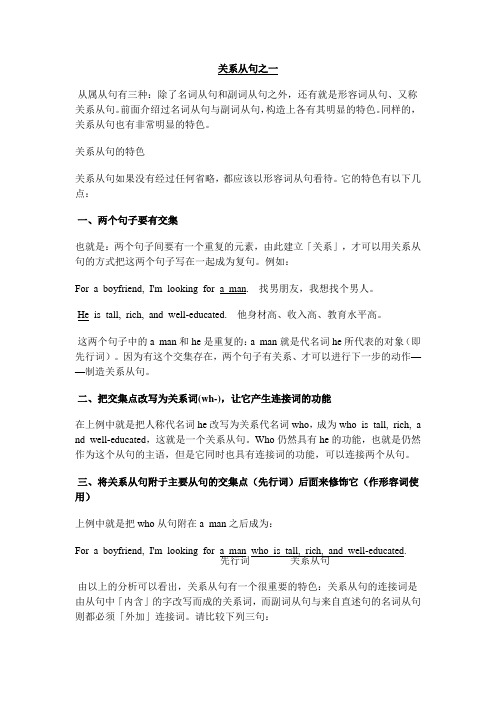
S V O(名词从句)
2.Iknowthis,because I have proof.我知道,因为我有证据。
S V O副词从句
1.Iknowsomethingwhich nobody else knows.我知道一件事,那是没有别人知道的。
何谓指示性
这里所谓的「指示性」,就是一般文法书所谓的限制用法(restrictive usage)。因为「限制」用法和「限定」从句(finite clause)这两个译名太接近、很容易混淆,所以我们换个比较容易理解的名称来说明这个观念。
关系从句如果具有指出「哪一个」的功能,我们称为具有指示性。如果关系从句具有指示性,关系代名词who或which才能够改成that。反之,如果关系从句并不具有指出「哪一个」的功能,而只是个可有可无的补充说明(一般文法书所谓的非限制用法nonrestrictive usage),那么这个关系从句通常要在前后加上一对逗点(也有可能是前面加逗点、后面刚好碰上句尾的句点之类)。这一对逗点可以视为一对括号看待。关系从句放在括号里面,表示这个关系从句不重要、只是个可有可无的补充说明,同时也表示这个关系从句不具有指示功能。这种关系从句,关系代名词只能用who或which,不能改为that。例如:
关系从句有没有指示性,最明显的线索是看它是否放在括号中(一对逗点中)。放在括号里(打了逗点)的东西不重要、只是补充说明,没有指示的功能。反之,具有指示性的关系从句是个重要条件、不能放在括号内,也就是不能打逗点。
看看上面第1句,关系从句who went to the same high school with me并没有用逗点隔开,表示它是一个重要条件、具有指出「哪一个朋友」的功能。「和我上同一所高中的那个」。关系从句具有指出「哪一个」的功能,关系代名词才能改为that(意思就是「那个」)。
进阶篇——第三章 关系从句
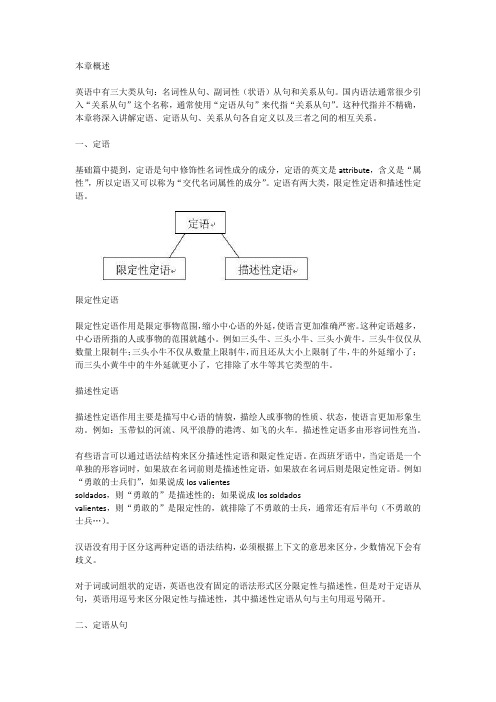
本章概述英语中有三大类从句:名词性从句、副词性(状语)从句和关系从句。
国内语法通常很少引入“关系从句”这个名称,通常使用“定语从句”来代指“关系从句”。
这种代指并不精确,本章将深入讲解定语、定语从句、关系从句各自定义以及三者之间的相互关系。
一、定语基础篇中提到,定语是句中修饰性名词性成分的成分,定语的英文是attribute,含义是“属性”,所以定语又可以称为“交代名词属性的成分”。
定语有两大类,限定性定语和描述性定语。
限定性定语限定性定语作用是限定事物范围,缩小中心语的外延,使语言更加准确严密。
这种定语越多,中心语所指的人或事物的范围就越小。
例如三头牛、三头小牛、三头小黄牛。
三头牛仅仅从数量上限制牛;三头小牛不仅从数量上限制牛,而且还从大小上限制了牛,牛的外延缩小了;而三头小黄牛中的牛外延就更小了,它排除了水牛等其它类型的牛。
描述性定语描述性定语作用主要是描写中心语的情貌,描绘人或事物的性质、状态,使语言更加形象生动。
例如:玉带似的河流、风平浪静的港湾、如飞的火车。
描述性定语多由形容词性充当。
有些语言可以通过语法结构来区分描述性定语和限定性定语。
在西班牙语中,当定语是一个单独的形容词时,如果放在名词前则是描述性定语,如果放在名词后则是限定性定语。
例如“勇敢的士兵们”,如果说成los valientessoldados,则“勇敢的”是描述性的;如果说成los soldadosvalientes,则“勇敢的”是限定性的,就排除了不勇敢的士兵,通常还有后半句(不勇敢的士兵…)。
汉语没有用于区分这两种定语的语法结构,必须根据上下文的意思来区分,少数情况下会有歧义。
对于词或词组状的定语,英语也没有固定的语法形式区分限定性与描述性,但是对于定语从句,英语用逗号来区分限定性与描述性,其中描述性定语从句与主句用逗号隔开。
二、定语从句在初级篇的定语从句中提到过,英语的定语从句放在后头,说的是什么人或什么东西已经在前边交代了,听的人就不着急了,因此英语里的定语可以很长。
从句语法详讲:主语从句、表语从句、状语从句、定语从句、同位语从句

《高中英语语法详细讲解》主语从句(3-5)、同位语从句(5-9)、表语从句(9-12)、定语从句(12-22)、非限制性定语从句(22-24)、状语从句(24-37)一、名词性从句百科名片在句子中起名词作用的句子叫名词性从句 (Noun Clauses)。
名词性从句的功能相当于名词词组, 它在复合句中能担任主语、宾语、表语、同位语、介词宾语等,因此根据它在句中不同的语法功能,名词性从句又可分别称为主语从句、宾语从句、表语从句和同位语从句。
名词性从句高考热点透视1. ___ is a fact that English is being accepted as an international language. (NMET 1995)A. ThereB. ThisC. ThatD. It答案D。
当名词从句在句中作主语时,为避免句子头重脚轻,常用it作形式主语置于句首,而将真正的主语从句放在句尾。
此时it只起先行引导作用,本身无实义。
此句也可以改写为:That English is being accepted as an international language is a fact.2.A computer can only do ____ you have instructed it to do.(NMET2001)A.how B.after C.what D.when答案C。
从句子结构可知,句子的空白处应该填引导宾语从句的连词,做主句谓语动词do的宾语,同时该连接词还是从句中的do的宾语,因此,此处的连接词应该用what。
3. He asked ____ for a violin.(MET1992)A. did I pay how muchB. I paid how muchC. how much did I payD. how much I paid答案:D。
宾语从句相当于特殊疑问句,句子语序要用陈述语序。
19.英语语法 Relative Clauses 关系从句

Relative clauses give more information about a subject or object. They usually follow and "agree" with the noun they modify and often occur between a Subject and Verb. However, they usually have no effect on the S + V relationship.Examples:The man who works at IBM comes from Hong Kong.The house that Jack built remains empty.The people who came to the party had a great time.Those who arrive early are entitled to a rebate.I ate an apple that had a worm in it.She is the one who I told you about.The man who lives over there is my uncle.One of the men who lives over there is my uncle.Only one of the people who work in the company is qualified.Most relative clauses use the words who, whom, whose, which, that, when or where.This is the place where I met my wife.Paul is the man who loves Mary. Simon is the man who(m)Mary loves. (subject position) (object position)Commas which set off relative clauses function like parentheses ( ) indicating non-essential information.My wife, who is a doctor, works at Community Hospital.My wife (who is a doctor) works at Community Hospital.Without commas, relative clauses specify one member of a group:My brother who is a scientist works at the university.My brother who is a mechanic works at Bob’s Garage.Specifies “which brother” (one of many)Sample usage from the article:•Other regions (which were) surveyed…•…part of a US-based programme (which is) known as…You may delete the relative pronoun (who, that, which) and the “be” verb when:1. they are followed by a prepositional phrase.A. The man who is in the house likes to watch television all day.The man in the house likes to watch television all day.B. The books that are on the desk are mine.The books on the desk are mine.2. the main verb in the relative clauseis progressive.A. The man who is swimming in the lake is my father.The man swimming in the lake is my father.B. The clothes that are lying on the floor belong to me.The clothes lying on the floor belong to me.3. the main verb in the relative clauseis passive.A. The survey which was conducted by the government did not indicate true public opinion.The survey conducted by the government did not indicate true public opinion.B. The food that was eaten by the mice was poisonous.The food eaten by the mice was poisonous.Same timeTime clauses with "while" and "when" can be reduced by deleting the subject and "be"verb.•While I was eating dinner, I watched television.•While eating dinner, I watched television.•When you are in Rome, (you) do as the Romans do.•When in Rome, do as the Romans do.If there is no "be" verb, change the verb in the subordinating clause to its -ing form.Sometimes the subordinator (when or while) can be deleted as well.•When I opened the door, I saw a strange sight.•When opening the door, I saw a strange sight.•Opening the door, I saw a strange sight.•While I was taking a shower, my sister called from California.•(NOT) While taking a shower, my sister called from California.Be careful when reducing time clauses that come at the end of sentences.•We saw many beautiful birds while we were fishing in the lake.•We saw many beautiful birds while fishing in the lake.•(NOT) We saw many beautiful birds fishing in the lake.In the last sentence, the meaning is ambiguous: Are we fishing or are the birds fishing?Different times•After I finished my homework, I went to bed.•After finishing my homework, I went to bed.•After I had finished my homework, I went to bed.•After having finished my homework, I went to bed.•Having finished my homework, I went to bed.•Before he left the dance, Jerry said good-bye to his girlfriend.•Before leaving the dance, Jerry said good-bye to his girlfriend.Other clausesSometimes clauses with because can be reduced.•Because he was a doctor, George knew how to handle the situation.•Being a doctor, George knew how to handle the situation.•As a doctor, George knew how to handle the situation.There are two types of relative clauses, restrictive and non-restrictive. Restrictive clauses specify which (of many) nouns the speaker is referring to. They do not require commas.For example,I have three brothers.My brother who lives in Virginia is a rocket scientist.My brother who lives in Ohio is a civil engineer.My brother who lives in Hawaii is a surfer.Each of the relative clauses in the above examples specifies a different brother. It tells “which one.”Non-restrictive clauses, on the other hand, are separated by commas. They merely give more information about the noun. In other words, they tell more about the same topic.The commas function as parentheses.I have one brother.My brother (who is from Oklahoma) is an architect.My brother, who is from Oklahoma, is an architect.Noun clause used as an objectHe said something . S V OHe said that he was sick .Noun clause used as a subjectSomething is your business. S VWhatever you do is your business.Someone is still in the cafeteria. S VWhoever ate my lunch is still in the cafeteria.What did he say?What is your business?Who is in the cafeteria?The subordinator may take the "subject" or "object" position in a noun clause. Note the usage of the following: Henry loves Mary. (S V O)Mary loves Jim. (S V O)The person who(m) Lee loves is a secret.The person who loves Tim is a secret.Who(m) Henry loves is a secret.Mary is the "object" of the sentence. Mary is the "subject" of the sentence.Relative clause (subordinator in obj. position)Relative clause (subordinator in subj. position) Noun clause (subordinator in obj. position) Noun clause (subordinator in subj. position)Who loves Tim is a secret.that what who whoever whatever whether whichwherewhenhowwhyifhow muchhow manyhow longhow farhow oftenwhoseRemember to preserve word order in noun clauses: I don’t know who he is.Whoever she is is not important.Whatever is in the box is a mystery.Can you tell me what he is doing?She doesn't undestand why he is leaving.I wonder how much that costs.Do you know how long it will take?。
高一英语必修一Unit4语法之定语从句之关系代词之that,which

2)The noodles that I looked were delicious. (宾语指物)
3)Let’s ask the man that is reading the book over there.
(主语指人)
4)The girl that we saw yesterday is Jim’s sister.
stayed up in the earthquake.
4.Those_w_h_o_ bring us happiness should be loved.
5.she is the girlw_h_o_/_w_h_o_m_/_th_a_t_/_/I met in the street yesterday.
(3)先行词被序数词或形容词最高级修 饰时或本身就是形容词最高级或序数 词时。
This is the first book (that) he has read.
(4)先行词既有人又有物时。
They talked about the men and the things that they saw.
Unit 4 Natural Disasters
Grammar2
一、课堂导入
找定从:1.找w2.翻译句意
1. She is my daughter who has been lost for many years. 2. The man who is talking with my father is a teacher. 3. The professor who you wish to see has gone abroad. 4. The woman (whom) you saw just now is my mother. 5. The teacher whom you are waiting for is coming. 6. This is the scientist whose name is known all over the country. 7. Nobody wants the house whose roof has fallen in. 8. He lives in a room whose window faces north.
英语语法-关系从句
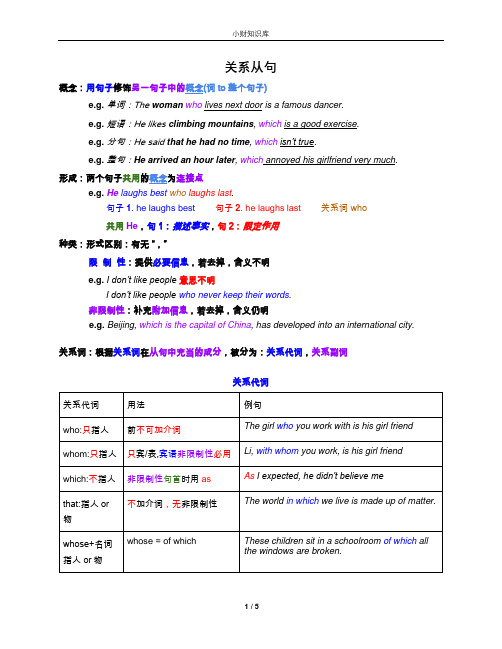
关系从句概念:用句子修饰另一句子中的概念(词 to 整个句子)e.g. 单词:The woman who lives next door is a famous dancer.e.g. 短语:He likes climbing mountains, which is a good exercise.e.g. 分句:He said that he had no time, which isn’t true.e.g. 整句:He arrived an hour later, which annoyed his girlfriend very much.形成:两个句子共用的概念为连接点e.g.He laughs best who laughs last.句子1. he laughs best 句子2. he laughs last关系词 who共用He,句1:描述事实,句2:限定作用种类:形式区别:有无“,”限制性:提供必要信息,若去掉,含义不明e.g. I don’t like people 意思不明I don’t like people who never keep their words.非限制性:补充附加信息,若去掉,含义仍明e.g.Beijing, which is the capital of China, has developed into an international city. 关系词:根据关系词在从句中充当的成分,被分为:关系代词,关系副词关系代词特殊关系代词as:正如限制性:只能用在such,the same,as,soe.g.a. He’ll repeat such points as are discussed in the book.b. Such a student as works hard will be sure to succeed.c. He tried to make as few mistakes as he could avoid.d. He is not the same playboy as we knew.非限制性:位于句首必须用ase.g.As is known, the whale is not fish but a mammal.代替全句:as:主从句内容一致 which:主从句内容互斥e.g.She has married again, as was expected.She has married again, which was unexpected.what:= 先行词 + 关系词单独使用:不能有先行词e.g. She is not what she used to be = She is not the girl that she used to be.what+名词:所有的…e.g.a. I will give you what help I can.b. What money I have has been given to you = All the money that I have…辨析:结构上也可以理解成名词从句,意思上如下名词从句:整个句子的意思e.g.What he said shows that he is cruel.what从句:只指what这个人或物e.g.He is not what he was a few years ago.than:主句有比较级e.g.a. Don’t drink more wine than is good for health.b. Don’t give him more money than is needed, since money will burn a hole in his pocket. but:= that/who/whom…note.g. a. There is no man but errs = There is no man who doesn’t err.b. There are few but admire his talent = There are few who do n’t admire his talent.c. There are very few people in this club but he knows =whom he doesn’t know.关系副词限制性 or 非限制性从句中必做状语介词+关系代词(whom/which/whose)动词/形容词搭配的介词,可前可后引导词辨析复杂定语从句。
- 1、下载文档前请自行甄别文档内容的完整性,平台不提供额外的编辑、内容补充、找答案等附加服务。
- 2、"仅部分预览"的文档,不可在线预览部分如存在完整性等问题,可反馈申请退款(可完整预览的文档不适用该条件!)。
- 3、如文档侵犯您的权益,请联系客服反馈,我们会尽快为您处理(人工客服工作时间:9:00-18:30)。
关系从句的理解与翻译
人们习惯称由关系代词that,which,who,whom,whose和关系副词when,where等引导的从句为“定语从句”,认为这种从句的功能同汉语定语相当,只不过英语的定语从句后置,汉语的定语前置罢了。
但随着对语言认识的不断深人,人们发现很多这样的从句不能用定语来翻译。
让我们先看一例:
1. Kennedy was rushed to a hospital where he died immediately.
若拘泥于“简短的定语从句可译为汉语前置定语”的观点,该句子就可能会被译为:
肯尼迪被急忙送到一家他很快就死的医院。
译文听上去荒谬可笑,仿佛送医院的目的是为了“很快就死”,这显然有悖原意。
这里“where”起过渡连接的作用,相当于“and there”,在语义上属另一新层次,绝无修饰,更无限制“怎样的医院”之意。
从句中“died”这一动作发生于主句中“was rushed”的动作之后,进一步交待了事情发展的结果。
可见,这种结构难用“定语从句”来解释。
因此有的语言学家主张将这种句子笼统称为“关系从句”。
这种正名有利于我们摆脱“定语”的吏缚,深入分析该类从句形形色色的内在关系。
所以,例1应译为:
肯尼迪被急忙送到一家医院,在那里他很快就死了。
让我们再多看几个例子:
2. When he was still a little boy, Jack London wrote some compositions which were praised by his teachers.
杰克·伦敦还是小孩时,他写的一些作文就受到老师的赞赏。
(不宜译为:……他就写受到老师赞扬的作文。
)
3. I met the boatman who then took me across the ferry.
我遇到了那位船夫,他将我渡到对岸。
(不宜译为:我遇到那位将我渡到对岸的船夫。
)
4. While they were waiting there, a dog from one of the houses down the road began a wild, hoarse howl that continued until a voice called out and hushed him.
他们正在那儿等时,从路边一幢房屋窜出的一条狗开始狂吠不止,直到有人出来喝住,它才停下来。
(不宜译为:……一条狗开始了直到有人出来喝住才停止的狂吠。
)
5. In the torchlight,he caught sight of a figure whom he immediately recognized as Bill Wilkines, our local grocer.
借着电筒的亮光,他看见一个人影,马上认出是当地杂货商比尔·威尔金斯。
(不宜译为:……他看见马上认出的是当地杂货商比尔·威尔金斯的影子。
)
我们知道,汉语由于缺乏关系代词、关系连词等连接手段,通常只有以时间或逻辑为轴线安排句子,对语序的依赖性极大,如果把后发生的事做前置定语就会显得很好笑,如“送到一家很快就死的医院”“写受老师赞扬的作文”。
而英语的连接手段相当丰富,构成信息焦点的中心词后面可马上由关系代词引导从句补充信息,从句中需补充信息的名词后又衍生出二度、三度……从句,但仍能使人感到句子层次清楚。
如:
6. The snake catches the toad that eats the insect that nibbles the green leaves that grow
on the branches.
遇到这种一个从句扣一个从句的句子,汉语只有以简驭繁:断句。
译为:
蛇吃癞蛤蟆,癞蛤蟆吃虫子,虫子吃生长在树枝上的绿叶子。
此外,读者也许注意到了:在1、2、3、4、5例中,抛开关系代词等结构不管,我们可明显察觉英语、汉语的语序同事件发生的时间顺序基本一致,这无疑是翻译转换的极好基础,只需在关系代词处断句,省掉关系代词,必要的话重复一下名词,照原文顺序翻译即可。
那么如果主、从句中谓语的动作是持续性的,或时序不清楚又怎么样呢?请看例句:
7. He is a professor who gives lectures in several universities this semester.
他是教授,这学期在几所大学兼课。
8. All this time I was living with a young married couple who interested me very much, for they were unlike any people had ever known.
这段时期我一直和一对年轻夫妇同住在一块儿,这对夫妇使我很感兴趣,因为他们同我以前所认识的人都不一样。
以上两例中主句传递了主要信息,从句传递了辅助信息,从另一侧面加以补充描述,或提供某种必要的背景知识,关系代词则起停顿、衔接、过渡的作用,使语义发展顺利进人另一层次,我们似乎察觉不到这些从句跟中心词之间有何限制或修饰关系。
有时关系代词和关系副词还体现了主、从句间的某种逻辑关系,不能简单地视为“代替”某个名词而同时接续从句的词。
如:
9. In 1906, however, Pierre, who was crossing a road, was run over and killed. (who…≈when he…)
1906年,皮埃尔在横穿马路时被车压死了。
10. Dr. Bethune, who was very tired on his arrival, set to work at once. (who was…≈though he was)
白求恩大夫刚到时虽然很累,但他立即便开始工作。
11. We know that a cat, whose eyes can take in many more rays of light than our eyes, can see clearly in the night. (whose eyes…≈because its eyes…)
我们知道,由于猫眼能比人眼吸收更多的光线,所以猫在夜里也能看得很清楚。
12. He would be a shortsighted commander who merely manned his fortress and did not look beyond. (who…≈if he…)
(谁如果)只守城堡而不往远处看,(那他)就是目光短浅的指挥官。
13. There was something original, independent and heroic about the plan that pleased all of them. (that…≈so that the Plan…)
这方案新领,有独创性,有魄力,(所以)他们都喜欢。
以上五例中,关系代词、副词在特定语境表示了时间、让步、原因、条件、结果等逻辑关系,意义上相当于状语从句,翻译时也当然不能译为定语。
另外,12、13两句的汉译中括号里的汉字省掉后意思仍然清楚而且显得更简洁、紧凑,这也是我们在翻译时应该考虑的。
传统语法囿于“定语从句”的观念,以关系代词前有无逗号为准,机械地将关系从句分为“限
制性定语从句”和“非限制性定语从句”,这是很不全面的。
我们应该深人理解原文的深层意思,尊重汉语的习惯,才能翻译出正确、地道的译文。
